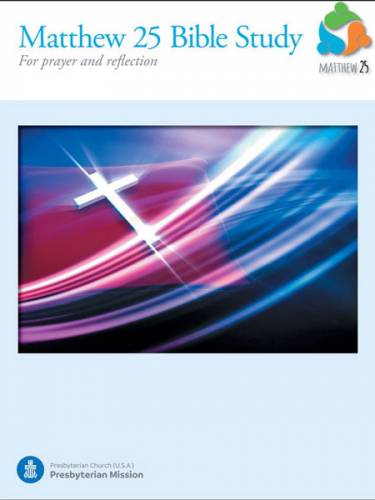‘Audacious’ vision is attainable only because of God’s abundance
by Mike Ferguson | Presbyterian News Service

LOUISVILLE — The vision for the Matthew 25 invitation is “admittedly audacious,” a new Matthew 25 resource acknowledges. The three Matthew 25 challenges — building congregational vitality, dismantling structural racism and eradicating systemic poverty — “are enormous.”
“And yet we affirm that God is always immeasurably greater,” states the Matthew 25 Bible Study for Prayer and Reflection, now available on the Matthew 25 invitation website. According to Paul’s letter to the Ephesians, God “is able to accomplish abundantly far more than all we can ask or imagine.”
The Rev. Dr. Diane Moffett, president and executive director of the Presbyterian Mission Agency; the Rev. Dr. Barry Ensign-George, coordinator for theology and worship; and the Rev. Dr. David Gambrell, associate for worship, co-authored the Bible study.
The Bible study sets Matthew 25, the judgment of the nations, in the context of Jesus’ four discourses that precede his parable of the sheep and goats: the Sermon on the Mount, Jesus’ introduction to the disciples when he sends them out on a mission, the parables found in Matthew 13 and Jesus’ teaching about the church.
The study has this to say about the three focus areas:
- Building congregational vitality — “If your church were to close, who would miss it and why?” the study asks. Congregations committed to the work and witness of Jesus Christ follow his example: He would “gather his followers, teaching them and modeling a very different way of life. Then, out of compassion for those in need, he would send them out in mission to teach, heal and confront evil. This rhythm of gathering and scattering is at the heart of worship and service of the church.”
- Dismantling structural racism is defined as “breaking down the laws, policies, practices and structures that reinforce and perpetuate discrimination, bias, prejudice and oppression of people of color.” Disparities encountered by people of color in housing, education, employment, health, immigration and incarceration “aren’t individual issues, but institutional injustices in our society … We follow the example of the early Christians, who sought to build new forms of community in which there was no longer Jew or Greek, slave or free, male or female.” In addition, “while the focus is on racial oppression, the intersectionality of racial oppression against other oppressed groups — including women, LGBTQIA+ people, and people who are disabled — is a vital consideration. We encourage Presbyterians to include efforts to combat discrimination and oppression of these groups under the rubric of racism.”
- Eradicating systemic poverty “refers to the elimination of the economic exploitation of impoverished people through laws, policies, practices and systems that perpetuate an impoverished state.” “We try to fix people who end up on the margins,” the study says. “While it is important to respond with compassion to each person who is impoverished, the bigger question is: What is causing them to end up and remain there?” Jesus wasn’t crucified for feeding the hungry and healing the sick, the authors point out. “He was persecuted and executed when he ‘troubled the waters’ — disturbing those with political, social and economic power … Confronting systems is challenging work — systems develop powerful defenses.”
The hopeful aspect of the third and final parable in Matthew 25, the study points out, is that we still have time to get our acts together.
“If the purpose of Jesus’s stories is to transform those who learn from them, then the good news in this story is that goats can become sheep,” the authors write. “It is our hope that the PC(USA) will align with the sheep so we may be transformed and become agents of transformation through Jesus Christ.”
![]() You may freely reuse and distribute this article in its entirety for non-commercial purposes in any medium. Please include author attribution, photography credits, and a link to the original article. This work is licensed under a Creative Commons Attribution-NonCommercial-NoDeratives 4.0 International License.
You may freely reuse and distribute this article in its entirety for non-commercial purposes in any medium. Please include author attribution, photography credits, and a link to the original article. This work is licensed under a Creative Commons Attribution-NonCommercial-NoDeratives 4.0 International License.